Enathe Hasabwamariya, Rwanda/USA
- Subscribe to RSS Feed
- Mark as New
- Mark as Read
- Bookmark
- Subscribe
- Printer Friendly Page
- Report Inappropriate Content
Navigation: 2018 Scholar Project ReferenceProject CommunitiesPage ConservationGIS Scgis.org
Enathe Hasabwamariya, Student, Antioch University USA/ Rwanda

 <--PDF Enathe 2018 Conference Talk MP4-->
<--PDF Enathe 2018 Conference Talk MP4-->
"About 60% of the world’s 660 primate taxa are threatened with extinction…Nyungwe National Park, a tropical montane forest in Rwanda, has a population of chimpanzees that face several threats, including bushmeat hunting, human wildlife conflict, and habitat degradation from forest fires and human encroachment….Preliminary results have shown that chimpanzees used areas adjacent to forest edges more than forest interior"
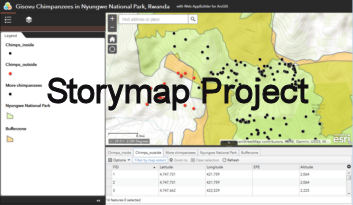
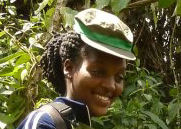 <-- Enathe Says "Hello" and talks about her work in GIS for Chimpanzee Conservation.
<-- Enathe Says "Hello" and talks about her work in GIS for Chimpanzee Conservation.
2018 Scholarship Program Storymap -->
to analyze the distribution patterns of chimps in relation to park border regions of Nyungwe National Park, Rwanda (requires scgis membership)
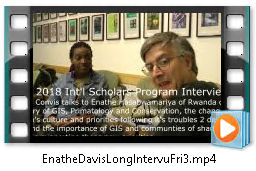
 <- 2018 Scholar Interview on her discovery of GIS, Primatology, the changes in Rwanda’ following the genocide, and the importance of GIS and communities of sharing like SCGIS in supporting these priorities.
<- 2018 Scholar Interview on her discovery of GIS, Primatology, the changes in Rwanda’ following the genocide, and the importance of GIS and communities of sharing like SCGIS in supporting these priorities.
2018 Conference Interview ---------> on how the Rwandan Genocide changed national feelings about wilderness
Enathe Hasabwamariya, Antioch University New England / Rwanda
Antioch University New England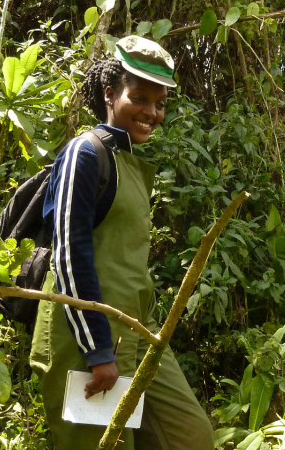
40 Avon Street
Keene, NH 03431
website: www.antioch.edu
your email: ehasabwamariya@antioch.edu or hassenny@gmail.com
Skype: enathe.hasabwe Facebook: Hasabwe Enathe WhatsApp: +250787254046
(Scgis Years: yr18 )
My interest in community leadership started when I was very young, at age 6, when I was living in an orphanage center with 300 kids, all survivors of the Rwandan Genocide, and I was in charge of all kids under 5. In this role, I helped them learn and practice their poetry, dances and other daily activities. During college, I was a class representative for four years. With my colleagues, we started a University of Rwanda Girls Leaders Forum (UR-GLF), where I was in charge of advocacy for girls on campus. In this position, I helped the counselling team by mentoring girls who had problems on campus, such as financial and social problems. Especially, we helped girls who had unwanted pregnancies on campus to get some financial and mental help. My interest in conservation comes from growing up around Nyungwe National Park in Rwanda. My main concerns were about the interaction between human and wildlife, which pushed me to study biology and conservation. In 2014, I joined the Global Youth Biodiversity Network, a group of young people working with the UN/ Convention on Biological Diversity to advocate for Biodiversity. In this network we attend several UN meetings on Biodiversity, to represent young people from different countries. Currently, I am a focal point to the Global Youth Biodiversity Network in Rwanda. During my Master’s degree at Antioch, for a period of one year, I served as a student representative in the Environmental Studies Department, where I attended monthly faculty meetings. I also organized several social events to connect students with faculty members.
photo: Tracking Chimpanzees
The most unique thing about my conservation work is that I am one of the fewest Rwandan professional primatologists in Rwanda. Rwanda is a very rich in different primate species, however there is a lack of primate research taking place in the country. This makes it challenging for students who are interested in studying primate conservation. Rwanda is a small landlocked country, with a very high population density (400-1000people/km2). It is home to a lot of biodiversity, including the endangered mountain gorillas and chimpanzees. In my work the most challenging thing, is the lack of trainings in conservation GIS, and the lack of data, including primate research data and GIS data. The local University doesn’t have enough capacity to train teachers and students about conservation GIS. As a primatologist, I am a member of the African Primatological Consortium for Conservation (APCC), which has given me opportunities to attend several meetings and trainings on primate’s conservation, including the use of SMART/CyberTracker and GPS data collection, basic GIS and other new technologies used in conservation. I also serve as a member of the Primate Specialist Group/Africa Section, of the IUCN Species Specialist Group (2016-2020).
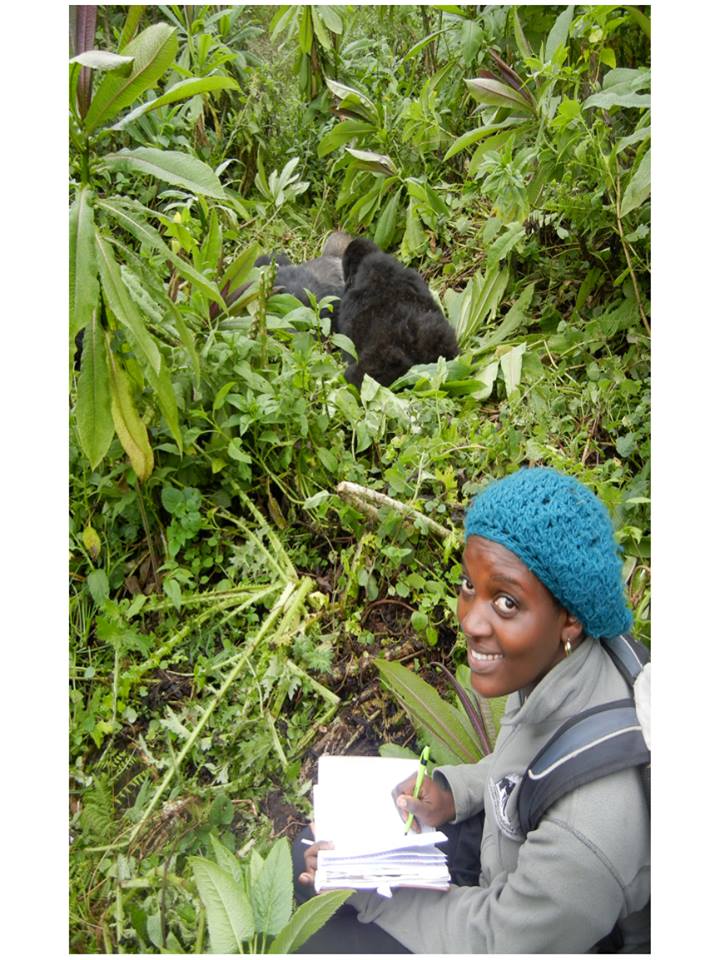
photo: studying mountain gorillas
Nowadays the work of conservation requires a lot of technical skills including GIS and Remote Sensing. For example, during my current project, GIS analysis helps me to develop land use/ land cover base maps and statistics to determine cover type and matrix surrounding Nyungwe Forest. Rwandan conservationists need GIS skills to understand land use related problems and human-wildlife conflicts. However, there is a lack of effective training for young Rwandan conservationists, lack of funding to attend different trainings. Trained GIS experts can help park managers and different policy makers to make effective decision regarding land use management and biodiversity conservation. Through SCGIS, I am really excited to potentially take part in a range of conservation GIS trainings both at Esri and at the University of California, Davis, and to attend my first GIS conferences. I have heard about both the Esri and the SCGIS conferences and they sound like amazing experiences to meet other people who are working in my field of conservation and to build my technical GIS skills. This training will help me to improve my skills in GIS and help me finish my project on chimpanzee conservation and land use planning around Nyungwe National Park, Rwanda. That is why I am applying for the SCGIS scholarship, to attend the Specialized SCGIS training at University of California-Davis, to attend the Esri trainings, to attend for the first time ever the Esri International User’s Conference and the SCGIS Conference. This is an incredible opportunity for me. This training will help me to improve my skills in GIS and help me finish my Master’s project on chimpanzee conservation and land use planning around Nyungwe National Park, Rwanda. This training is a great opportunity for me, since I want to develop my career in conservation and apply GIS as a tool to help increase our knowledge of biodiversity hotspots and impacts of land cover and land use change on wildlife habitats.
History: My first introduction to GIS was during college at the University of Rwanda, where I took a class on introduction to GIS. Since then, I became very interested after learning its application and value to conservation biology. In 2012, I started using GIS, working with the International Gorilla Conservation Program, on a water use survey project in collaboration with local communities living around protected areas in Virunga massif, Rwanda. I collected GPS points of every household I surveyed and the location of water sources both inside and outside the park. In 2014, I worked with the Wildlife Conservation Society (WCS-Rwanda) on a chimpanzee habituation project for tourism in Nyungwe National Park, Rwanda. In 2015, I used GIS for a fisheries project, where I helped map all the lakes in Akagera National Park in order to study fish biodiversity in those lakes. Currently, I am using GIS in my Master’s project to understand the ranging patterns of chimpanzees in relation to forest edges and human activities in Nyungwe National Park, Rwanda.
About your home: Rwanda is a very small landlocked country with a very high population density in Africa. The country’s biodiversity is mostly found inside protected areas, which are all surrounded by a very high human population (between 400-1000hab/1km2) whose survival rely on forest resources. This high density increases the pressure on the park and wildlife inside the park, including the endangered chimpanzees. Similar to other natural forests fragments surrounded by different land use types, NNP is subject to edge effects of differing extent and magnitude, dependent on shape, size, aspect and edge contrast (type of surrounding land use). During my research in Nyungwe, chimpanzees were found using areas adjacent to humans, destroying beehives in the search for honey. GIS skills help to understand the land use changes and its impact on biodiversity conservation. However, the lack of trained GIS experts is a challenge to conservation in many developing countries.
About your organization: Antioch University New England, is one of the five campuses of Antioch University, founded in 1964. It is one of the first University to have an interdisciplinary program in Environmental Studies. The mission of Antioch University is to offer learners transformative education in a global context that fosters innovation and inspires social action. I am currently finishing Masters student in Environmental Studies program, Conservation Biology Concentration at Antioch University New England.
Local SCGIS work: I am new to the SCGIS, the first time I heard about it was from friends here on campus, but then I was connected to it through my friend and mentor through the African Primatological Consortium for Conservation (APCC), Janet Nackoney, who is leading the SCGIS, Washington, DC chapter.
Local Community Work: My first experience teaching was in 2014, when I was an intern for WWF-Madagascar, with my colleagues. We taught French and English to local villagers in Beheloke. During this internship, I also helped develop a tool book on eco-tourism. We wrote five eco-guide books in French and English.
2018 Conference Presentation Title / Abstract:
“Influence of forest edges and human activities on the ranging patterns of chimpanzees”
About 60% of the world’s estimated 660 primate taxa are threatened with extinction, and more
than 75% have declining populations due to human pressure (Estrada,2017). Growing human
populations and the resulting anthropogenic pressures, such as habitat fragmentation, are the
strongest threats to primates living in tropical forests. Nyungwe National Park (NNP), a tropical montane forest in Rwanda, has a population of chimpanzees that face several threats, including bushmeat hunting, human wildlife conflict, and habitat degradation from forest fires and human encroachment. Considering that NNP is surrounded by very high human population density, there is a need to understand how people and chimpanzees interact in order to develop effective conservation strategies. The main objectives of this research are to assess the use of forest edges by chimpanzees along the border of NNP and determine the influence of human activities on chimpanzee ranging patterns. For this study, we designed transects perpendicular to the forest edges, and recorded chimpanzee signs along those transects. Vegetation Sampling was done to understand the habitat type along the edges and in the forest interior. To determine the influences of human activities on chimpanzee ranging patterns, transects parallel to edges were set outside the forest and chimpanzees movement was mapped. I expected that chimpanzees would use forest edges more than forest interior, following food and nesting trees availability. Preliminary results have shown that chimpanzees used areas adjacent to forest edges than forest interior. In this study, chimpanzees nesting trees were highly abundant between 300-500 meters from forest edges with seemed to influence chimpanzee movement. Regarding the influence of human activities, chimpanzees were found in areas adjacent to beehives and were found destroying people’s beehives. The time shortage was a limitation to this study, thus in the future, I would like to use GIS to understand how different land use types/matrix around Nyungwe influence chimpanzee movement outside the park. This will help the park managers on how to prevent chimpanzee-human conflicts.
xPark xPrimate xHabitat xForest xHumanWildlife xConflict x2018Scholar x2018Talk xScholar xTalk xRwanda xAfrica xWomen xPOC
You must be a registered user to add a comment. If you've already registered, sign in. Otherwise, register and sign in.